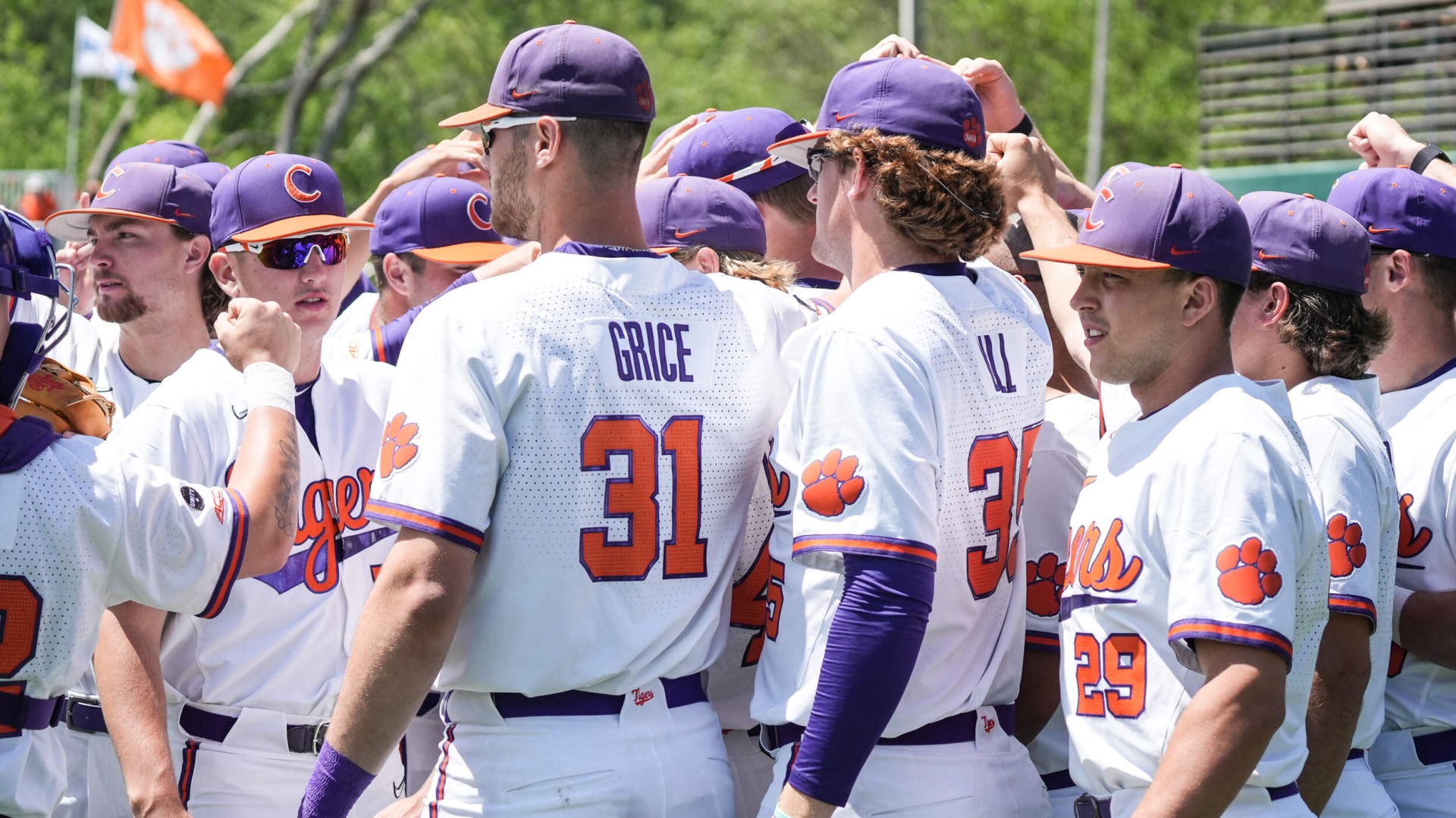
By William Qualkinbush
Back on April 9th, the Clemson baseball team lost to Notre Dame in South Bend by a score of 9-3. After a rock solid 14-0 start, the Tigers were slumping big time, finding themselves in a 5-12 slump that included a disappointing 2-9 record in ACC play.
I was there in South Bend. It was not fun. I wouldn’t blame anyone who had major questions about the prospects for Clemson baseball moving forward, both inside and outside the program.
But now, things are looking up again. After a come-from-behind win over Florida State on Sunday—the second such victory of the weekend—Monte Lee’s ball club has won 7 of its last 9 games. A 6-11 ACC mark is still not great, but the needle is pointing up after consecutive series wins.
There are always multiple factors that spark a turnaround. Some of them are apparent in the moment, while others may take a while to reveal themselves. Here are the reasons why I think Clemson will continue moving in the right direction when they get back to action against Presbyterian:
1) Max Wagner looks like the ACC’s best player.
During the final games of that Notre Dame series, something notable occurred. In front of a slew of family and friends who made the trek down from Wisconsin, Wagner clubbed two home runs in an otherwise rough display by the Tigers’ offense.
Instead of being a one-off performance, Wagner has made such efforts a way of life in recent days. Over his past ten games, the sophomore from Green Bay has 17 hits in 39 at-bats and has slugged nine home runs. He recently wrapped up a stretch of five consecutive games with a homer in which he hit seven long balls, including the game-winning grand slam on Friday night against Florida State.
His slash line of .436/.500/1.065 over that ten-game stretch would make him the best player in the country. For the season, he leads the ACC with a 1.345 OPS, the gold standard of measurement for offensive players. In addition, he’s as good as he’s ever been with the glove at third base.
If the season ended today, Wagner would get my vote for ACC Player of the Year. Certainly he won’t keep up this torrid pace, but given his improvements in making contact and his ability to drive the ball gap-to-gap even before his power surge, I don’t expect him to slow down very much in the heart of the Clemson lineup.
2) The new rotation looks promising.
For the season, roughly 45 percent of Clemson’s innings pitched have come from its starting pitchers. Needless to say, that’s simply not enough work to keep the burden from falling on a bullpen that has been pretty dang good but has also dealt with some injuries in key series.
The main reason the Tigers haven’t been able to stretch out their starters is the inability to avoid hard contact. Nick Hoffmann and Nick Clayton have been valuable arms for a while for the Tigers, but opponents have hit .314 and .289 against them, respectively.
Enter Geoffrey Gilbert and Billy Barlow. Gilbert made his first career start on Saturday against the Seminoles and showed why he has been the most trusted arm in Clemson’s bullpen for years now. His tight-spinning two-seam fastball is a major weapon that induces a lot of empty swings. He should be able to stick in that Saturday slot.
Barlow, meanwhile, is a super freshman that many expected to enter the rotation well before now. Still, his coaches wanted to see a little more consistency from him in the midweek starting role. He is a fierce competitor whose best weapon is his ability to attack down on the corners with all of his pitches.
Last weekend, Clemson got 12.2 combined innings from its starters, the most since the Miami series in mid-March. Expect that number to go up in Louisville this week.
3) There has been a positive domino effect that started with Blake Wright.
Much like Wagner, Wright came into the season as a glove-first player at second base with some potential pop in his bat. After losing early at-bats to transfer Tyler Corbitt, the Florida native has now started 17 consecutive games. He has reached base in 16 of those appearances, ranks second on the squad with eight home runs, and leads the team with a .368 batting average in league play.
Wright’s emergence has been great for him for sure, but the effects of his uptick in production have been felt across the board. With Wright established at second base, Lee has been freed up to move Corbitt to left field, where he has stabilized an otherwise disappointing Tiger outfield.
Now either Jonathan French or Cooper Ingle can DH when they don’t hit, and Caden Grice can DH when the staff plans to pitch him. David Lewis has had a bunch of good ABs as a right-handed DH, as well, and the team hasn’t lost anything on the defensive side. None of those moves would be nearly as easy to make if Wright hadn’t arrived on the scene.
4) There is both strength and parity in the ACC.
On its face, this may seem like an interesting item to throw into the strengths column. There are two main reasons why these dynamics work in Clemson’s favor.
First, on the strength aspect: As of April 25th, 10 of the 14 teams in the ACC rank inside the top 40 of the RPI. This includes Clemson, which occupies the 35th spot. In other words, every series has the ability to boost the Tigers’ RPI standing.
Now, to the parity piece: The Tigers are currently in 13th place in the league with the aforementioned 6-11 mark. That isn’t good since only 12 teams qualify for the ACC tournament. However, with 12 games left to play, only 3 games separates Clemson from 6th-place Florida State. Lots of teams are bunched up around the .500 mark inside the conference.
In addition, most of the other teams in the ACC have played an extra conference series at this point. Clemson has a greater opportunity to make up ground than its competitors do to create breathing room in the final month of the regular season.
5) The weather is better.
Guaranteed this one will be met with an eye roll or two from the crowd that thinks every reason is an excuse. Perhaps my greatest reason for optimism after the 2-9 start in the ACC was related to this, however.
During those first 11 league games, Clemson had to travel to both Pittsburgh and Notre Dame. Three of the five games in those series were played either in snow and sleet or in snowy conditions, and the Friday game at Notre Dame was brutally cold. For a relatively warm-weather team like Clemson, that is a significant disadvantage that is statistically improbable to achieve with two cold-weather series on the road during the first half of league play.
Even at home, the Saturday game against Miami was played with ridiculous wind conditions that didn’t play to Clemson’s advantage. Looking ahead, although the Tigers must still travel to Louisville and Virginia, the weather should be much better in those locations than it would have been a month ago.
Listen, there are no excuses. Clemson should have played better at Pitt and Notre Dame. It’s also true that certain teams are built for certain conditions when we’re talking about outdoor sports. I don’t think it should shock anyone that after coming back home to warmer weather and more pleasant conditions has given the Tigers’ play a boost.









